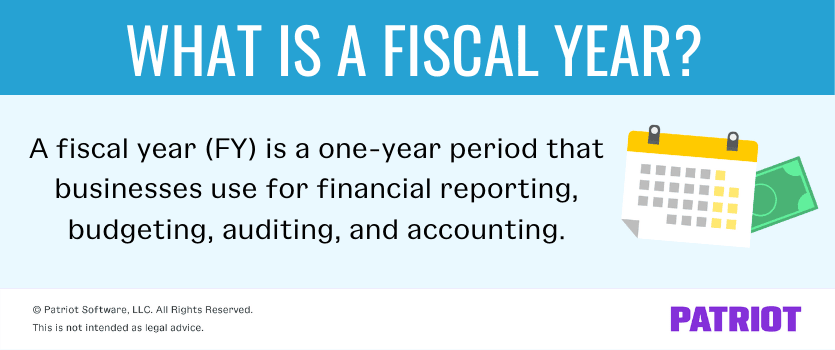When it comes to pulling reports, establishing a business budget, and filing taxes, you need to know your company’s fiscal year. So, what does a fiscal year mean, exactly? When does the fiscal year start? And, how long is a fiscal year? Read on to get the answers to these questions and more.
What is a fiscal year?
Fiscal year definition: A fiscal or financial year (FY) is a one-year period that businesses use for financial reporting, budgeting, auditing, and accounting. An FY consists of 12 months or 52 weeks (or 53 weeks in some cases).
An FY can be a fiscal calendar year and go from January 1 – December 31. But, a business’s fiscal year doesn’t have to correspond with the standard calendar year. Some businesses’ fiscal years may start in the middle of the year (e.g., a university begins and ends its FY according to the school year).
Your company’s fiscal year can help you accurately measure revenue and earnings from year to year. Not to mention, it can be helpful when it comes to setting goals, reviewing financial statements, and creating your business budget.
What is the difference between fiscal year and calendar year?
Again, a business’s fiscal year can vary. Some businesses’ fiscal years may start in October, while others may align with a normal calendar year and begin on January 1.
On the other hand, a calendar year is always January 1 – December 31 each year. So, a business’s fiscal year-end date could be September 30 while its calendar year-end is December 31.
You typically have the option to choose between your own fiscal year or using the calendar year for tax and reporting purposes. However, the IRS requires some businesses to use the calendar year (e.g., S corporation).

Fiscal year examples
Because fiscal years can vary from business to business, let’s take a look at a few examples of common fiscal years in business:
- January 1 – December 31 (also a calendar year)
- February 1 – January 31
- April 1 – March 31
- July 1 – June 30
- October 1 – September 30
Some businesses might not have their end of fiscal year on the last day of a month. Instead, they might end on the same day each year, such as the last Friday in March.
Or, they might choose a company fiscal year that ends closest to a certain day (e.g., Saturday closest to August 31). This is where 53-week fiscal years can come into play.
Fiscal year and taxes
Again, the IRS allows companies to be either calendar year or fiscal year taxpayers. However, some entities may need to use the calendar year method from the get go. Typically, the following use the fiscal calendar year:
- Sole proprietors
- Partners in a partnership
- Shareholders of an S Corp
- Personal service corporations
If you’re unsure if you’re required to use the calendar year for tax and financial purposes, check with your accountant or the IRS.
According to the IRS, you must also adopt the fiscal calendar year if you:
- Keep no books or records
- Have no annual accounting period
- Have a present tax year that does not qualify as a fiscal year
- Are required to use a calendar year by the IRS or Income Tax Regulations
So, how can your fiscal year impact your taxes? Fiscal years allow you to reduce your tax burden by spreading expenses and income over the same period of time. If you have low or high sales during a certain time of the year, an FY can help you see a more accurate financial picture.
Your fiscal year also impacts your tax deadline. So, be sure to know when your fiscal year ends so you can pay and file your taxes on time. For example, a corporation with a year-end date of December 31 must file and pay taxes by the 15th day of the fourth month after the end of the company’s financial year (April 15). However, if a corporation’s fiscal year ends on June 30, they must file by the 15th day of the third month.
Determining your FY
As a business, you determine your fiscal year when you file your first income tax return. Consider the following factors when choosing your fiscal year:
- Type of business
- Business cycle
- IRS requirements
Again, the IRS may require your type of business structure to use the calendar method. Do your research to see if you’re required to use a certain fiscal year. If you’re not required to use the fiscal calendar year, think about your peak sales times when selecting your company’s fiscal year.
For more information on IRS rules on fiscal years, check out these resources:
Changing your business’s FY
Businesses establish their fiscal year when they file their first income tax return. After you set your tax year, you may need to get IRS approval to switch it. To get approval, file Form 1128, Application To Adopt, Change, or Retain a Tax Year.
Certain types of businesses, like sole proprietorships and S corporations, must coordinate their fiscal year with the calendar year. Businesses who use the calendar year for their fiscal year can use Form 1128 to change their tax year with the IRS.
If you qualify for automatic approval, you do not have to pay a user fee when filing the form. If you do not qualify for automatic approval, you must request a ruling and pay a fee.
If you plan on changing your business’s FY, check Form 1128’s instructions for more information or consult the IRS.
This article was updated from its original publication date of November 18, 2014.
This is not intended as legal advice; for more information, please click here.



